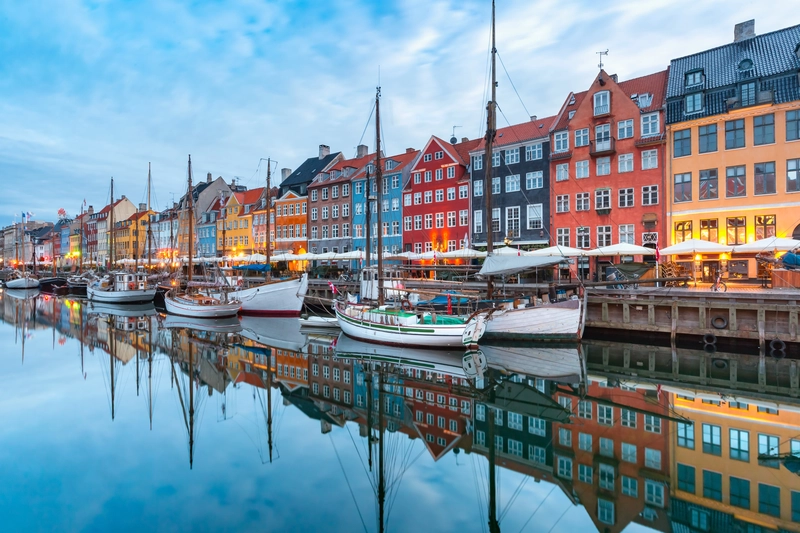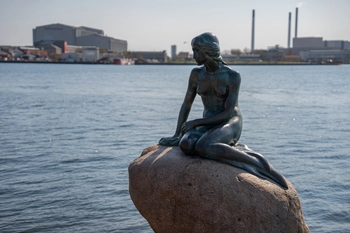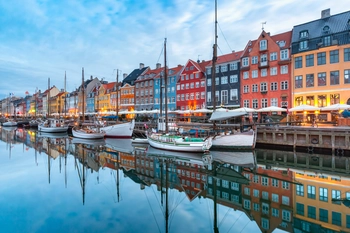- Historical Background
- Copenhagen
- Roskilde
- Legoland
- Hygge
- Tips and recommendations
- Frequently Asked Questions
- What is the capital of Denmark?
- What currency does Denmark use?
- Are credit cards accepted in Denmark?
- What is the best time to travel to Denmark?
- What is the population of Denmark?
- What language do they speak in Denmark?
- Do I need a visa for Denmark?
- Is Denmark a safe country?
- Holidays in Denmark
Denmark: The Land of Hygge and Happiness
This page contains affiliate links. This means that I get a commission if you purchase through my links, at no cost to you.

Denmark is a small but influential Nordic country located in Northern Europe. It’s the southernmost of the Scandinavian countries and shares a border with Germany to the south, surrounded by the North Sea to the west and the Baltic Sea to the east. The country is made up of the Jutland Peninsula and over 400 islands, of which Zealand, Funen, and Bornholm are the most well-known.
- Table of Contents
Historical Background
Denmark’s history dates back over a thousand years and is closely linked with the Viking Age. During this time, Danish Vikings were known for their seafaring and raiding across Europe. By the 10th century, Denmark was a unified kingdom, and it has maintained one of the oldest continuous monarchies in the world. Throughout the centuries, Denmark played a significant role in European history, including during the Kalmar Union, when it was united with Sweden and Norway under a single monarch.
In the 19th century, Denmark experienced territorial losses, most notably to Prussia, but it has since focused on developing a strong, peaceful society with an emphasis on social welfare and democracy. Today, Denmark is known for its high quality of life, robust welfare system, and commitment to environmental sustainability.
Copenhagen
Copenhagen, located on the eastern coast of the island of Zealand, is Denmark’s capital and largest city. It is a vibrant metropolis known for its historical and modern attractions. The city has a rich cultural scene, with landmarks such as the colorful Nyhavn harbor, the iconic Little Mermaid statue, and the historic Tivoli Gardens amusement park.
Copenhagen is also a hub of innovation and design. The city’s architecture blends the old and the new, with striking examples like the Royal Danish Playhouse, the futuristic Black Diamond Library, and the award-winning urban development of Ørestad. Copenhagen is also famous for its culinary scene, with several Michelin-starred restaurants, including the world-renowned Noma.
Roskilde
Before Copenhagen, the city of Roskilde served as Denmark’s capital. Located just west of Copenhagen on the island of Zealand, Roskilde is one of Denmark’s oldest cities, with roots dating back to the Viking Age. It was a significant religious and political center during the Middle Ages and was the site where many of Denmark’s early kings were buried.
Roskilde Cathedral, a UNESCO World Heritage site, is a must-visit landmark. This stunning gothic cathedral has been the burial site for Danish monarchs since the 15th century and is a testament to the city’s historical importance. Roskilde is also famous for the Viking Ship Museum, which houses well-preserved Viking ships and offers insights into the maritime culture of the Vikings.
Today, Roskilde is perhaps best known for the Roskilde Festival, one of Europe’s largest music festivals, attracting thousands of visitors each year.
Legoland
For a taste of Danish creativity and fun, head to Billund, Jutland, where you’ll find Legoland—a theme park dedicated to the iconic LEGO brick, which was invented in Denmark in 1932 by Ole Kirk Christiansen. The park opened in 1968 and has since become one of Denmark’s most popular tourist attractions, drawing visitors from around the world.
Legoland Billund features themed areas with intricate models made entirely out of LEGO bricks, including famous landmarks, interactive rides, and shows that appeal to both children and adults. The park is a celebration of creativity and imagination, reflecting the global success of LEGO as a brand.
Hygge
Hygge is a Danish word that embodies the feeling of coziness, warmth, and contentment. It’s about enjoying life’s simple pleasures, whether it is sharing a meal with family, lighting candles on a cold evening, or relaxing with a good book. Hygge is more than just a word—it’s a way of life in Denmark, emphasizing comfort, togetherness, and finding joy in everyday moments. It’s all about creating a peaceful, welcoming atmosphere where you can unwind and connect with those around you.
If you are looking to experience hygge firsthand, you can book a walking tour with a local guide who will take you through the charming streets of Copenhagen, introducing you to the best spots for embracing hygge, from cozy cafes to hidden corners of the city that capture this unique Danish lifestyle.
Tips and recommendations
- Don't get Danish Kroner before you arrive in Denmark
Are you planning to get Danish Kroner? Don’t go to Travelex, but wait until you are in Denmark. Airports are full of ATMs that will give you a much better exchange rate. The ATM will ask you if you want to withdraw with or without currency conversion. You should always choose the latter. This means your local bank will exchange the money and this is the best exchange rate for you. This can save you up to 10%. Don't get too much cash. Card payments are really popular in Denmark.
Frequently Asked Questions about Denmark
- What is the capital of Denmark?
The capital of Denmark is Copenhagen, which is a highly sought after spot in Scandinavia. Tourists from all over are drawn to the iconic Little Mermaid statue and enjoy leisurely walks along the harbor, taking in the beautiful sights.
- What currency does Denmark use?
Denmark uses the Danish Krone (DKK) as its official currency.
- Are credit cards accepted in Denmark?
Yes, credit cards are widely accepted in Denmark. Visa and MasterCard are commonly used, and you can also find contactless payment options in many places.
- What is the best time to travel to Denmark?
The best time to visit Denmark is during the summer months, from June to August. This is when the weather is relatively mild, and you can enjoy outdoor activities, festivals, and the beautiful coastline. Spring and early autumn can also be pleasant times to explore the country.
- What is the population of Denmark?
The population of Denmark is around 5.8 million people.
- What language do they speak in Denmark?
The official language of Denmark is Danish. English is also widely spoken and understood, especially in urban areas and among younger generations.
- Do I need a visa for Denmark?
Visa requirements can vary based on your nationality and the purpose of your visit. Citizens of many countries within the European Union (EU) and the Schengen Area do not need a visa for short stays (up to 90 days) in Denmark. However, it's essential to check the latest visa requirements and regulations based on your specific situation before you travel.
- Is Denmark a safe country?
Denmark is considered one of the safest countries in the world. Crime rates are relatively low, and the country has a strong social and political environment. It's generally safe to travel and explore, but exercising common-sense precautions is always recommended.
Holidays in Denmark
| Date | Name |
|---|---|
| Jan. 1, 2025 | New Year's Day |
| April 17, 2025 | Maundy Thursday |
| April 18, 2025 | Good Friday |
| April 20, 2025 | Easter Sunday |
| April 21, 2025 | Easter Monday |
| May 29, 2025 | Ascension Day |
| May 30, 2025 | Bank closing day |
| June 5, 2025 | Constitution Day |
| June 8, 2025 | Pentecost |
| June 9, 2025 | Whit Monday |
| Dec. 24, 2025 | Christmas Eve |
| Dec. 25, 2025 | Christmas Day |
| Dec. 26, 2025 | St. Stephen's Day |
| Dec. 31, 2025 | New Year's Eve |






